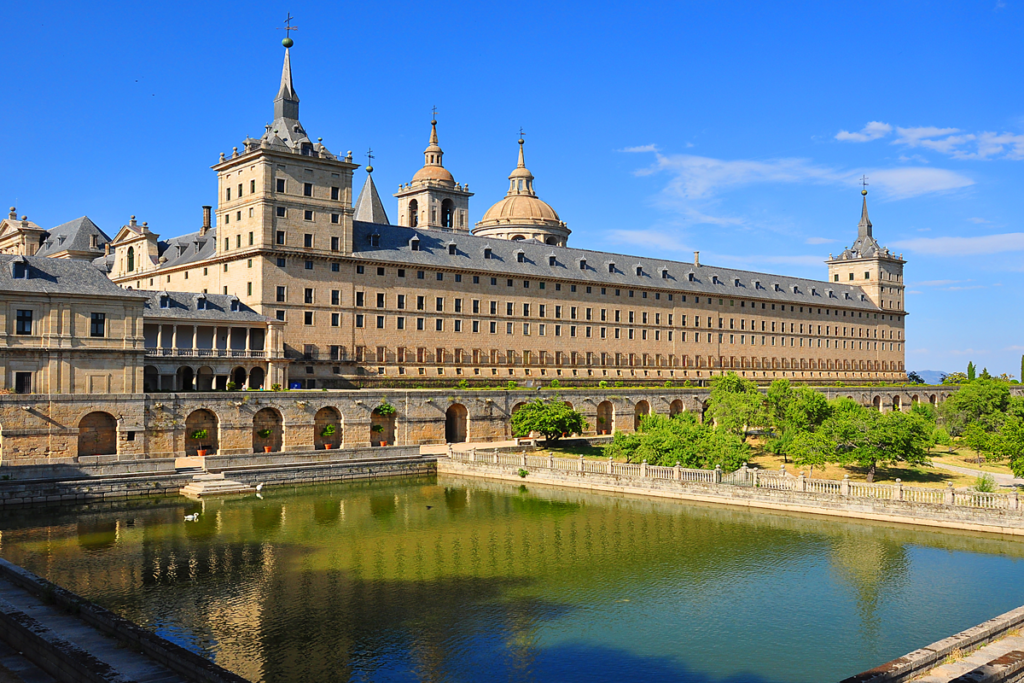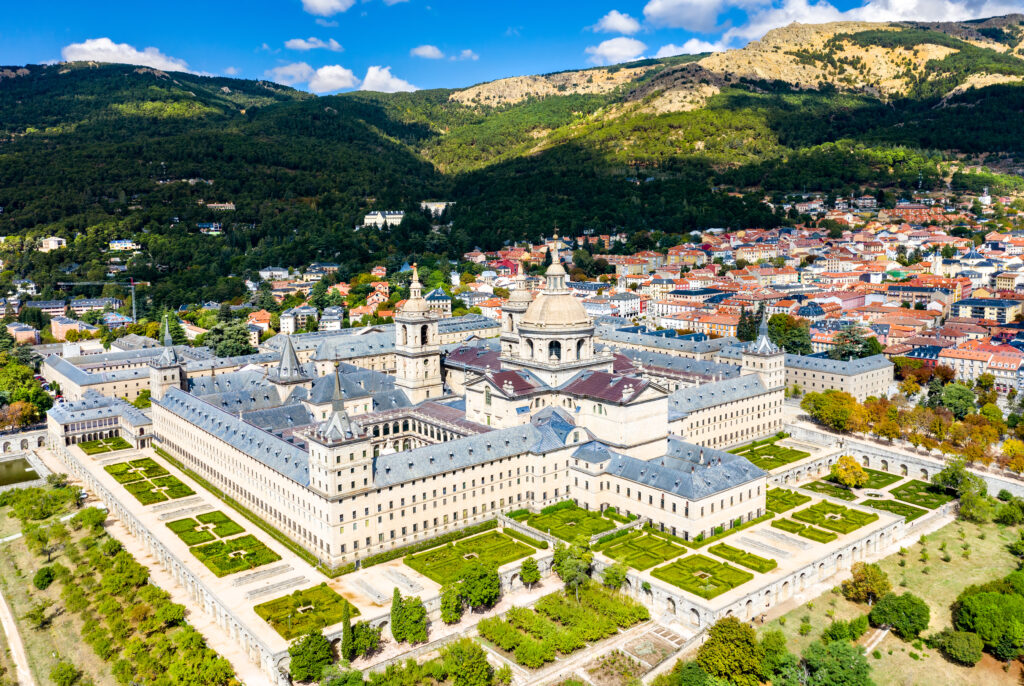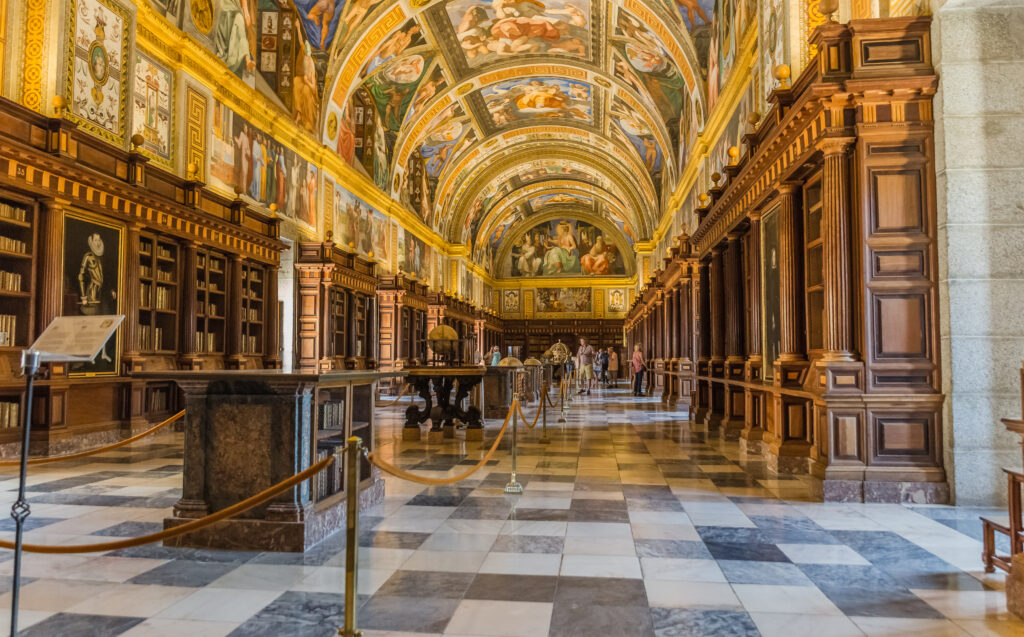
EL ESCORIAL
Felipe II had a compulsion for building new things in inconsequential places. In 1561 he upped and moved the capital of Spain from Toledo to the tiny village of Madrid. Two years later he selected a remote mountain foothill to build The Monastery of St. Lawrence of El Escorial (El Escorial for short) – a project so formidable that it would become known as the 8th wonder of the world. This puts El Escorial on a scale with the pyramids, which also utilized incredible amounts of resources.
El Escorial was the capstone of Spain’s wealth and dominance in Europe. This massive structure contains a monastery, a basilica, a royal palace and the final resting place for centuries worth of Spanish sovereigns (all but three, to be precise). El Escorial nearly bankrupted the throne (twice!) during construction, but was built to last – insulating the crown from an empire that would eventually crumble around it.
An industrious family to the town of San Lorenzo de El Escorial has the opportunity to add one more site to the itinerary: Felipe II’s Seat.
Get to / from El Escorial
There are multiple opportunities per hour to travel from Madrid to the town of San Lorenzo de El Escorial. The train and bus each take about an hour.
By train: Catch the C3a line of the Cercanías suburban train system at Atocha, Chamartin or Nuevos Ministerios (twice an hour during the week and less so on the weekend). The train station in San Lorenzo de El Escorial is over a km away from El Escorial itself. From there you can take the local bus for a modest fee or enjoy a 20-minute walk through Parque y Jardines de la Casita del Príncipe.
By bus: The 661 and 664 buses both leave from the Madrid bus terminus (and Metro stop) Moncloa. The advantage of the buses is that they deposit riders much closer to El Escorial than the train. The buses leave at a minimum of twice per hour September through June (and less so July through August).
By car: You can shave a little bit of time off your commute to San Lorenzo de El Escorial by driving. There are several public parking areas surrounding El Escorial.
The Day
Consider buying tickets to El Escorial online ahead of time. Closed Mondays. Open 10:00 am – 6:00 pm October through March. Open 10:00 am – 8:00 pm April through September. Tickets are €15. Children under 5 are free. Your tickets will coincide with a 15-minute time window to enter, so synchronization with your arrival time is critical.
Please note that San Lorenzo de El Escorial is almost always cooler than Madrid, so bring an extra layer of clothing.

The town of San Lorenzo de El Escorial and El Escorial itself are synonymous. It’s kind of a chicken and the egg scenario, as the town was essentially created to build El Escorial and has been there to support it ever since. The fact that both are named after the martyrdom of Saint Lawrence (burned on top of an iron grill over a slow fire) sets a somber tone for what you’re about to see.
This tone will be reinforced upon arrival. Before you is the austere exterior to the most ambitious building of Renaissance Spain. El Escorial represents the duality of the mid-16th century Spanish Golden Age and pinpoints a very specific moment in time. It’s the wealthiest empire in the world thanks to exploits in the New World, meanwhile there’s a Catholic populace headed by an extremely pious king, Felipe II.
This was the time of the Counter Reformation in which Spain and the rest of the Catholic world was fighting the expansion of Protestantism. The Council of Trent was held by Catholic powers to make all sorts of policy changes to combat Protestantism. These changes extended to architectural edicts.
Felipe II took the Council of Trent very seriously, so El Escorial would focus on clarity and forgo much ornamentation. If you’re going to build the best, you need to hire the best. This meant bringing on Juan Bautista de Toledo as chief architect, a Spaniard who had assisted Michaelengelo with St. Peter’s Basilica in Vatican City – a big name hire. But, projects of this scale require decades of time and Juan Bautista did not live to see the completion of El Escorial. He was replaced by Juan de Herrera whose own name would come to describe the severe classicism of the structure – “herreresque.”
For all this so-called architectural restraint we’re still talking about a structure with 11 courtyards and 4,000 rooms. If you could’ve peered through one of the 2,675 windows 4 centuries ago, you would’ve seen monks and clergy tending to the duties of the basilica and monastery. You would’ve also seen a fully functioning palace, as the royal court would bring all their pomp from Madrid every summer.
The austere exterior sets up the visitor for some beautiful contrasts inside. The basilica absolutely soars to the heavens with a stunning altarpiece featuring Tibaldi’s “The Martyrdom of St. Lawrence.” The modest bed of Felipe II (ultimately his deathbed) is adjacent to the basilica with a view of the altar. El Escorial has always been a repository of art, as many pieces in The Prado were first hung on these walls.
Beneath the basilica is the Pantheon of Kings, the final resting place for all but three Spanish kings and their queen consorts. Basically, if you were a king or gave birth to one, you are allowed to stay here for eternity in a lead chest. Remember, El Escorial was originally built for the remains of Carlos V (Felipe II’s dad). Although all these sarcophagi are the same size, as Holy Roman Emperor and kickstarter of the Hapsburg lineage in Spain, Carlos V enjoys the most prominent position.
The Pantheon of Infantes is below the monastery, forever enforcing the fact that even in the afterlife, these are princes, princesses, wives and illegitimate children who were never going to become king or queen. There were lots of infantes – nine chapels worth.

The library’s colorful frescoes and curved ceiling create a vibrant room for reading and reflecting on sacred texts. Not that you’re allowed to page through the library’s collection, but many volumes are as beautiful as the room itself, hand illuminated by monks.
Once inside, El Escorial is about 90% accessible with a stroller. There are uneven cobblestones and some narrow thresholds to navigate. There are some steps between rooms, though visitor access is mostly on the main floor. The two Pantheons are, of course, down flights of stairs.
To truly appreciate the scale of El Escorial try walking around it! The far corner of the reflecting pool is the ideal spot to take a picture. If you want to proceed with the more aggressive itinerary, this is the time to begin your hike to Seat of Felipe II.
Seat of Felipe II
This is a novice level hike that will take you from El Escorial to a granite outcropping that Felipe II is believed to have used as a vantage point to watch the construction of his ambitious undertaking. A moderately fit person can make the round trip in about an hour. Do not attempt with a stroller unless you have one that’s been on hikes before and will respond to road, gravel and uneven terrain. If you have an apparatus to strap your child to your person, this is the time to use it.
Starting by Parque Adolfo Suarez, near the reflecting pool, the path to Seat of Felipe II is occasionally marked and not too complicated to follow. Nonetheless, we recommend pre-loading a Google Map illustrating the ideal walking route that skirts a golf course before ascending to the outlook.
Felipe II was a notorious micro manager. He got very caught up in the design and day-to-day minutiae of El Escorial’s construction. It’s been argued that Felipe II was so wrapped up in this project that he often shirked the responsibility of running an empire. So, enjoy the same view Felipe II did for the two decades of construction. Below you is a building that represents the pinnacle of Spain’s power and marks its gradual decline. By the time the project was complete Felipe II had quintupled Spain’s debt. Maybe this ‘seat’ was also a place for Felipe II to hide out from Swiss and Italian debt collectors.
Lunch in San Lorenzo de El Escorial
As we’ve noted, the town is there because of El Escorial. That being said, there is a large pocket of restaurants between the charming parallel streets Calle Floridablanca and Calle Del Rey. It should be understood that a number of these establishments are tourist traps and turn over frequently. Nevertheless, the tree covered Plaza Jacinto Benavente is an irresistible location to sit outside. The nearby Plaza de la Constitution is more wide open and offers glimpses of spires, turrets and mountain tops beyond the square.